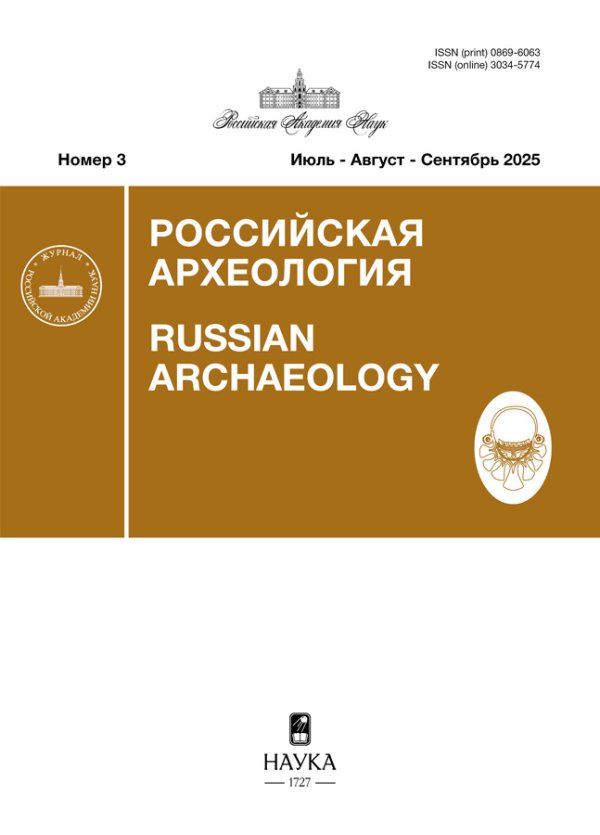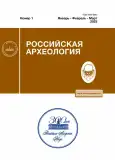EASTERN EUROPEAN CHAMPLEVE ENAMELS: COMPOSITION, TECHNOLOGY, AND THE ISSUE OF IDENTIFYING PRODUCTION CENTRES (RED OPAQUE ENAMEL)
- Authors: Rumyantseva O.S.1, Khanin D.A.2,3
-
Affiliations:
- Institute of Archaeology RAS
- Academician Korzhinsky Institute of Experimental Mineralogy RAS
- Lomonosov Moscow State University
- Issue: No 1 (2023)
- Pages: 84-100
- Section: ARTICLES
- URL: https://journals.rcsi.science/0869-6063/article/view/138833
- DOI: https://doi.org/10.31857/S0869606323010178
- EDN: https://elibrary.ru/MCHITH
- ID: 138833
Cite item
Full Text
Abstract
The composition of 139 samples of red enamel items from different regions of Eastern and Central Europe was studied using the SEM-EDS method. Most of the enamels were made following the “recipe” of provincial Roman enamellers; in some cases “ordinary” red glass was used. The high degree of standardization of the “recipes” for the manufacture and colouring of Roman glass and enamel does not make it possible to distinguish between the products of different manufacturing centres in most cases. At the same time, the peculiarities of the composition of spurs suggest the existence of specialized centres for their production, while specific features of penannular brooches suggest the possibility of distinguishing some types originating from the Baltic region. The heterogeneity of enamels with the “classical” composition indicates the functioning of numerous enamel workshops, rather than a centralized production.
About the authors
Olga S. Rumyantseva
Institute of Archaeology RAS
Author for correspondence.
Email: o.roumiantseva@mail.ru
Russia, Moscow
Dmitry A. Khanin
Academician Korzhinsky Institute of Experimental Mineralogy RAS; Lomonosov Moscow State University
Author for correspondence.
Email: d.khanin@iem.ac.ru
Russia, Chernogolovka; Russia, Moscow
References
- Akhmedov I.R., 2018. Finds of the circle of East European enamels in the Volga and Oka regions. Bryanskiy klad ukrasheniy s vyemchatoy emal’yu vostochnoevropeyskogo stilya (III v. n.e.) [Bryansk hoard of ornaments with champlevé enamel of the East European style (3rd century AD)]. A.M. Oblomskiy, ed. Moscow: Institut arkheologii Rossiyskoy akademii nauk; Vologda: Drevnosti Severa, pp. 146–158. (Ranneslavyanskiy mir, 18). (In Russ.)
- Akimov D.V., Zin’kovskaya I.V., Mulkidzhanyan Ya.P., 2020. Accidental finds of enamels in the forest-steppe Don region: description, reconstruction, interpretations. Germaniya – Sarmatiya [Germania – Sarmatia], III. O.A. Radyush, ed. Moscow: Institut arkheologii Rossiyskoy akademii nauk, pp. 244–257. (In Russ.)
- Bateson J.D., Hedges R.E.M., 1975. The scientific analysis of a group of Roman-age enamelled brooches. Archaeometry, vol. 17, iss. 2, pp. 177–190.
- Birkina N.A., 2023. Items from the circle of barbarian enamels in the State Historical Museum: source analysis and some technological aspects. Rossiyskaya arkheologiya [Russian archaeology], 1. (In Russ.)
- Bitner-Wróblewska A., 2019. The Chronology of East European enameled artefacts from the Baltic lands and from the the Przeworsk and Wielbark cultures. Kratkie soobshcheniya Instituta arkheologii [Brief Communications of the Institute of Archaeology], 254, pp. 171–190. (In Russ.)
- Bitner-Wróblewska A., 2011. East European enamelled ornaments and the character of contacts between the Baltic Sea and the Black Sea. Inter Ambo Maria. Contacts between Scandinavia and the Crimea in the Roman period. I. Khrapunov, F.-A. Stylegar, eds. Kristianabad; Simferopol: DOLYA, pp. 11–33.
- Bitner-Wróblewska A., Stawiarska T., 2009. Badania technologiczne wschodnioeuropejskich zabytków zdobionych emalią. Bałtowie i ich sąsiedzi. A. Bitner-Wróblewska, G. Iwanowska, eds. Warszawa: Państwowe Muzeum Archeologiczne w Warszawie, pp. 303–352.
- Bryanskiy klad ukrasheniy s vyemchatoy emal’yu vostochnoevropeyskogo stilya (III v. n.e.) [Bryansk hoard of ornaments with champlevé enamel of the East European style (3rd century AD)]. A.M. Oblomskiy, ed. Moscow: Institut arkheologii Rossiyskoy akademii nauk; Vologda: Drevnosti Severa, 2018. 560 p. (Ranneslavyanskiy mir, 18).
- Freestone I.C., 2015. The Recycling and Reuse of Roman Glass: Analytical Approaches. Journal of Glass Studies, 57, pp. 29–40.
- Freestone I.C., Stapleton C.P., Rigby V., 2003. The Production of Red Glass and Enamel in the Late Iron Age, Roman and Byzantine Periods. Through a Glass Brightly: Studies in Byzantine and Medieval Art and Archaeology Presented to David Buckton. C. Entwistle, ed. Oxford: Oxbow Books; Oakville: David Brown Book Company, pp. 142–154.
- Galibin V.A., 2001. Sostav stekla kak arkheologicheskiy istochnik [Glass composition as an archaeological source]. St. Petersburg: Peterburgskoe Vostokovedenie. 216 p.
- Gorokhovs’kiy E.L., 1982. Penannular brooches of the Middle Dnieper region with a champlevé enamel. Arkheologiya [Archaeology], 38, pp. 16–36. (In Ukrainian).
- Henderson J., 1991a. Chemical and Structural Analysis of Roman Enamels from Britain. Archaeometry ’90. E. Pernichka, G.A. Wagner, eds. Basel: Birkhauser Verlag, pp. 285–294.
- Henderson J., 1991b. Technological Characteristics of Roman Enamels. Jewellery Studies, 5, pp. 65–76.
- Khomyakova O.A., 2019. Enameled ornaments from the Prussia Museum collection. Kratkie soobshcheniya Instituta arkheologii [Brief Communications of the Institute of Archaeology], 254, pp. 227–252. (In Russ.)
- Kontny B., Lewoc I., 2018. Pierwsza ostroga zdobiona polami emalii z ziem polskich, albo o radości płynącej z bycia archeologiem. Studia Barbarica: Profesorowi Andrzejowi Kokowskiemu w 65. rocznicę urodzin, 1. B. Niezabitowska-Wiśniewska, ed. Lublin: Uniwersytetu Marii Curie-Skłodowskiej, pp. 333–353.
- Korzukhina G.F., 1978. Predmety ubora s vyemchatymi emalyami V – pervoy poloviny VI v. n.e. v Srednem Podneprov’e [Adornment items with champlevé enamels of the 5th – first half of the 6th century AD in the Middle Dnieper region]. Leningrad: Nauka. 122 p. (Arkheologiya SSSR. Svod arkheologicheskikh istochnikov, E1-43).
- Krenke N.A., 2011. D’yakovo gorodishche: Kul’tura naseleniya basseyna Moskvy-reki v I tys. do n.e. – I tys. n.e. [The Dyakovo fortified settlement: Culture of the Moskva River basin’s population in the 1st millennium BC – 1st millennium AD]. Moscow: Institut arkheologii Rossiyskoy akademii nauk. 548 p.
- Myzgin K.V., Radyush O.A., Lyubichev M.V., 2020. New evidence to the late date of objects from the circle of “champlevé enamels” in the Dnieper region. Germaniya – Sarmatiya [Germania – Sarmatia], III. O.A. Radyush, ed. Moscow: Institut arkheologii Rossiyskoy akademii nauk, pp. 198–219. (In Russ.)
- Oblomskiy A.M., Terpilovskiy R.V., 2007. Adornment items with champlevé enamels on the territory of the forest-steppe zone of Eastern Europe (supplement to the register by G.F. Korzukhina, I.K. Frolov and E.L. Gorokhovsky). Pamyatniki kievskoy kul’tury v lesostepnoy zone Rossii (III – nachalo V v. n.e.) [Sites of the Kiev culture in the forest-steppe zone of Russia (3rd – early 5th century AD)]. A.M. Oblomskiy, ed. Moscow: Institut arkheologii Rossiyskoy akademii nauk, pp. 113–141. (Ranneslavyanskiy mir, 10). (In Russ.)
- Peake J., Freestone I., 2012. Cross-craft interactions between metal and glass working: slag additions to early Anglo-Saxon red glass. Integrated Approaches to the Study of Historical Glass: IAS 12. W. Meulebröck, ed. Brussels: Bellingham, 842204. (Proceedings of the International Society for Optical Engineering, 8422).
- Pobol’ L.D., Kharitonovich Z.A., 2019. Champlevé enamels of the Roman period on the territory of Belarus. Slavyane na territorii Belarusi v dogosudarstvennyy period [Slavs on the territory of Belarus before the formation of state], 1. O.N. Levko, V.G. Belevets, eds. 2nd edition. Minsk: Belaruska navuka, pp. 148–199. (In Russ.)
- Radyush O., 2013. The second and third century knob spurs (Knopfsporen) in the Middle and Upper Dnieper area. Inter Ambo Maria. Northern barbarians from Scandinavia towards the Black Sea. I. Khrapunov, F.-A. Stylegar, eds. Kristianabad; Simferopol: DOLYA, pp. 317–334.
- Radyush O.A., 2020а. Barbarian enamels of Eastern Europe – the current state of the source base and mapping experience. Germaniya – Sarmatiya [Germania – Sarmatia], III. O.A. Radyush, ed. Moscow: Institut arkheologii Rossiyskoy akademii nauk, pp. 316–353. (In Russ.)
- Radyush O.A., 2020б. New area of the circle of champlevé enamels in the Orel area of the Upper Oka region. Kraevedcheskie zapiski [Local history notes], 13. Orel: Kartush, pp. 140–156. (In Russ.)
- Radyush O.A., 2020в. Spreading of “barbarian” enamels in the Upper Dnieper and the Seversky Donets regions in the territory of Kursk and Belgorod regions of Russia (materials for the catalogue). Germaniya – Sarmatiya [Germania – Sarmatia], III. O.A. Radyush, pp. Moscow: Institut arkheologii Rossiyskoy akademii nauk, pp. 154–185. (In Russ.)
- Radyush O.A., 2021. New data on the spreading of the items from champlevé enamel circle in the Upper Dnieper, Neman, Western Bug, Western Dvina, Lovat regions in Belarus and Russia (materials for the catalogue). Ekspedytsyya pratsyaglastsyu ў zhytstse: zbornik navukovykh artykulaў pamyatsi Alyaksandra Plavinskaga [Lifelong expedition: Collected articles in memory of Alexander Plavinsky]. N.A. Plavinskiy, ed. Minsk: Kolorgrad, pp. 59–105. (In Russ.)
- Rumyantseva O.S., Saprykina I.A., Voroniatov S.V., Trifo-nov A.A., Khanin D.A., 2021. Chemical and technological analysis of objects with champlevé enamels from the collection of the State Hermitage Museum. Rossiyskaya arkheologiya [Russian archaeology], 1, pp. 86–101. (In Russ.)
- Rumyantseva O., Bitner-Wróblewska A., Khanin D. Eastern European enamelled objects from the State Archaeological Museum in Warsaw: chemical composition and the issue of the origin (In preparation).
- Rumyantseva O.S., Skvortsov K.N., Khanin D.A. Enameled items from the Kaliningrad museum and the chemical composition of enamels. Kratkie soobshcheniya Instituta arkheologii [Brief Communications of the Institute of Archaeology]. (In print). (In Russ.)
- Rumyantseva O.S., Trifonov A.A., 2020. On the composition of the enamels from the Tezikovo and Abramovo burial grounds. Arkheologiya Volgo-Okskogo regiona [Archaeology of the Volga-Oka region]. Moscow: Gosudarstvennyy istoricheskiy muzey, pp. 106–112. (In Russ.)
- Rumyantseva O.S., Trifonov A.A., 2021. Drinking horn and spurs from burial 28 of the Skalistoye III burial ground in southwestern Crimea: glass and enamel composition and data on origin. Istoriya i arkheologiya Kryma [History and archaeology of the Crimea], XIV. V.V. Mayko, ed. Simferopol’: ARIAL, pp. 57–70. (In Russ.)
- Rumyantseva O.S., Trifonov A.A., Khanin D.A., 2018. Chapter 15.1. Chemical composition of glass enamel insets and beads. Bryanskiy klad ukrasheniy s vyemchatoy emal’yu vostochnoevropeyskogo stilya (III v. n.e.) [Bryansk hoard of ornaments with champlevé enamel of the East European style (3rd century AD)]. A.M. Oblomskiy, ed. Moscow: Institut arkheologii Rossiyskoy akademii nauk; Vologda: Drevnosti Severa, pp. 199–220. (Ranneslavyanskiy mir, 18). (In Russ.)
- Schibille N., Degryse P., Corremans M., Specht C.G., 2012. Chemical Characterisation of Glass Mosaic Tesserae from Sixth-Century Sagalassos (South-West Turkey): Chronology and Production Techniques. Journal of Archaeological Science, vol. 39, iss. 5, pp. 1480–1492.
- Shinakov E.A., Chubur A.A., 2020. Lunular pendants from the circle of “barbarian champlevé enamels” in the Middle Desna region. Germaniya – Sarmatiya [Germania – Sarmatia], III. O.A. Radyush, ed. Moscow: Institut arkheologii Rossiyskoy akademii nauk, pp. 116–127. (In Russ.)
- Vorontsov A.M., 2020. Finds of the circle of East European champlevé enamels on the territory of the Moshchiny culture. Germaniya – Sarmatiya [Germania – Sarmatia], III. O.A. Radyush, ed. Moscow: Institut arkheologii Rossiyskoy akademii nauk, pp. 258–275. (In Russ.)
- Voronyatov S.V., Rumyantseva O.S., Saprykina I.A., 2020. Apparel items with champlevé enamels from the State Hermitage Museum: archaeological analysis of the collection. Rossiyskaya arkheologiya [Russian archaeology], 3, pp. 16–32. (In Russ.)
Supplementary files


















